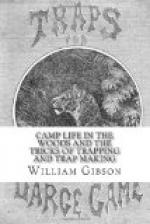[Illustration]
HOOP NOOSES.
This is a variation from the above, the noose being attached to a barrel hoop and the latter being fastened to two stout posts, which are firmly driven into the ground. By their scattering the bait inside the hoop, and adjusting the loops, the contrivance is complete.
This is a very old and approved method.
In the initial (T) at the head of this section we give also [Page 41] another suggestion for a noose trap. The cross pieces are tacked to the top of the upright, and a noose suspended from each end,—the bait adjusted as there seen.
We have mentioned horse-hair nooses as being desirable, and they are commonly used; but, as it takes considerable time to make them, and the wire answering the purpose fully as well, we rather recommend the wire in preference. We will give a few simple directions, however, for the making of the horse-hair nooses, in case our readers might desire to use them instead.
Select long, stout hairs from the tail of any horse, (we would recommend that it be a good tempered horse), take one of the hairs and double it in the middle, hold the double between the thumb and fore-finger of the left hand, letting the two ends hang from the under side of the thumb, and keeping the hairs between the thumb and finger, about a third of an inch apart. Now proceed to twist the two hairs toward the end of the finger, letting them twist together as the loop emerges on the upper side of the thumb.
A little practice will overcome what at first seems very difficult. To keep the two hairs between the fingers at the right distance of separation, and at the same time to twist them and draw the loop from between the fingers as they are twisted, seems quite a complicated operation; and so it will be found at first. But when once mastered by practice, the twisting of five nooses a minute will be an easy matter. When the entire length of the hairs are twisted, the ends should be cut off even and then passed through the small loop at the folded end. The noose is then ready to be fastened to the main string of support. Horse-hair nooses are commonly used in nearly all snares as they are always to be had, and possess considerable strength. The fine brass wire is also extensively used, and the writer rather prefers it. It is very strong and slips easily, besides doing away with the trouble of twisting the loops, which to some might be a very difficult and tedious operation. We recommend the wire, and shall allude to it chiefly in the future, although the horse-hair may be substituted whenever desired.




